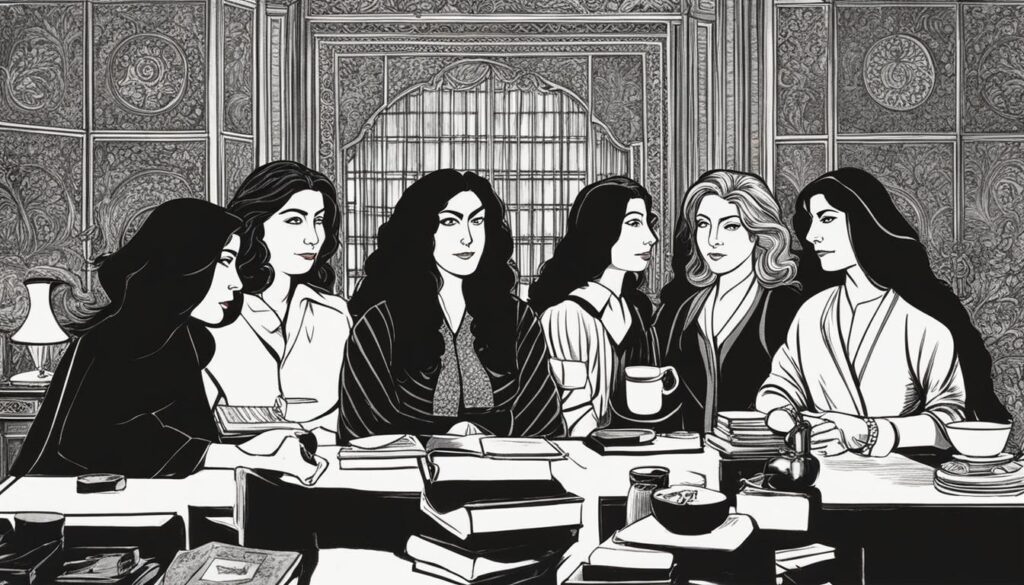Welcome to our comprehensive audiobook review of “The Complete Persepolis” by Marjane Satrapi. This compelling graphic memoir chronicles the author’s childhood and adolescent experiences growing up in Iran during the Islamic revolution. The audiobook version, narrated by Marjane Satrapi herself, provides a unique listening experience that brings the captivating story to life. In this article, we will provide an in-depth analysis of the audiobook, including its plot, themes, production, and its overall impact on readers and listeners.
Key Takeaways
- “The Complete Persepolis” is a gripping graphic memoir that explores Marjane Satrapi’s experiences growing up in Iran during the Islamic revolution.
- The audiobook version is narrated by the author herself and provides a unique listening experience.
- The audiobook’s production and narration quality are top-notch, making it an excellent listening choice for fans of the memoir.
- “The Complete Persepolis” incorporates various themes such as political unrest, identity, and family dynamics, making it a thought-provoking read.
- The memoir’s artwork and visual elements are unique and add to the storytelling experience, making it an engaging read for graphic novel enthusiasts.
About “The Complete Persepolis”
“The Complete Persepolis” is a graphic memoir written by Marjane Satrapi, an Iranian-born author and illustrator. The memoir depicts the author’s experiences growing up in Iran during the Islamic Revolution and the war with Iraq, as well as her subsequent journey to Europe.
Satrapi’s unique perspective as a woman living under the oppressive regime in Iran offers readers a poignant and intimate portrayal of a country grappling with political upheaval and social change. Through her own experiences, Satrapi provides a nuanced portrait of Iranian culture, highlighting both its rich history and the challenges of modern times.
Satrapi’s graphic illustrations are an integral part of the memoir, providing a visceral and visually engaging storytelling experience. Her stark black-and-white style conveys both the stark realities of life in Iran and the richness of its cultural heritage.
“The Complete Persepolis” has garnered widespread critical acclaim, with many praising Satrapi’s masterful blending of personal memoir and social commentary. The book has also been adapted into a successful feature film and an audiobook, making it accessible to audiences around the world.
Plot Summary
The “Complete Persepolis” is a graphic memoir by Marjane Satrapi that chronicles her growing up in Iran during and after the Islamic Revolution. The book tells the story of Marjane, who is just a child when the Revolution begins, and takes us through her journey as she navigates her identity under the new regime, separating from her family and eventually leaving the country to study in Austria. Throughout the memoir, Marjane grapples with issues of faith, family, love, loss, and the complexities of navigating a suddenly changing society.
The storyline is presented in a poignant and thought-provoking manner, with the numerous black and white graphic illustrations capturing the life and times of both young Marjane and the society that she lives in. The artwork is often stark and striking, with characters and expressions presented in a way that often captures the mood and sentiment of the text perfectly.
Overall, “The Complete Persepolis” is a haunting and moving work that captures the essence of growing up in a country undergoing massive social and political upheaval, making for a unique and captivating read.
Narration and Production
In the audiobook version of “The Complete Persepolis,” the narration and production quality is exemplary, bringing the graphic memoir to life through vocal expression and skillful sound design. The narration is performed by the author, Marjane Satrapi, providing an authentic and intimate connection to the story.
The production quality is exceptional, with clear and crisp sound quality that enhances the listening experience. The voice acting talent also contributes to the engaging narration, capturing the emotional depth of the characters and maintaining authenticity throughout the audiobook.
The skillful use of sound effects elevates the listening experience, creating a vivid soundscape that immerses the audience in the world of Persepolis. The production team carefully selected and integrated sound effects that added an extra layer of depth and meaning to the story.
The narration and production of the audiobook version of “The Complete Persepolis” further enhances the impact and emotional resonance of Satrapi’s graphic memoir, creating a dynamic listening experience that is not to be missed.
Themes and Messages
“The Complete Persepolis” is not merely a graphic memoir but a reflection on Iran’s past, present, and future. Throughout the audiobook, Satrapi skillfully weaves various themes and messages, making it a socially conscious work of art.
Themes in Persepolis
Through the protagonist Marjane’s eyes, Satrapi offers a unique perspective on the complexities of identity, cultural conflict, and political unrest. One of the central themes of the audiobook is the struggle to find one’s place in the world, depicted through Marjane’s experiences growing up in Iran and later as an immigrant in Austria. Another theme is the human desire for freedom and rebellion against oppression, which is highlighted in Marjane’s involvement in the Iranian Revolution.
Satrapi’s graphic illustrations bring to life these themes, enabling readers to better empathize with Marjane and understand the underlying issues.
Social Commentary
Moreover, “The Complete Persepolis” is a social commentary on Iranian society and culture. Satrapi exposes the Islamic Republic’s limitations, including censorship, gender inequality, and the surveillance state’s omnipresence. She also bravely critiques Western perspectives on Iran, challenging misconceptions and stereotypes.
Overall, Satrapi’s masterpiece invites readers to contemplate and question issues of social justice and human rights, making it a timely and relevant work of art that speaks to audiences worldwide.

Artwork and Visuals
The artwork in “The Complete Persepolis” is an integral part of the graphic memoir’s success. Marjane Satrapi’s unique illustration style creates a visually stunning depiction of her story that enhances the overall reading experience.
“I remember the first time I showed my book to my friends, and their reaction was, ‘Wow, it’s so visual.’ And I thought, ‘What are you talking about? It’s a book, of course, it’s visual.'” – Marjane Satrapi
Satrapi’s use of black and white illustration with varying shades of gray effectively captures the emotions and atmosphere of each scene. The simple yet powerful illustrations bring the characters to life and convey the intense and complex themes of the memoir.
The graphic illustrations in “The Complete Persepolis” also effectively showcase the cultural differences between Iran and the Western world. Satrapi uses contrasts in dress, architecture, and social customs to emphasize the clash of cultures and provide a deeper understanding of her story’s historical and cultural context.
The visual storytelling in “The Complete Persepolis” is further enhanced by the use of speech bubbles, text boxes, and other graphic elements. These tools are used to add humor, depth, and insight to the story, creating a richer and more engaging reading experience.
Character Analysis
The characters in “The Complete Persepolis” are pivotal to the coming-of-age story of Marjane Satrapi. Each character presents an aspect of Iranian society, offering commentary on the cultural, political, and social conditions prevalent at the time.
Marjane Satrapi is the main character and narrator of the graphic memoir. As a young girl, she is curious, rebellious, and unafraid to question the norms of the society she lives in, but as she grows up, she faces numerous challenges that force her to mature and adapt to her surroundings. Her character development is particularly noteworthy, as she navigates the complexities of adolescence and adulthood while straddling the line between her Iranian identity and her Western education.
Mother and Father, Marjane’s parents, also play significant roles in the memoir. They are portrayed as supportive, progressive, and liberal-minded, which contrasts with the dominant conservative Islamic culture of Iran. Through their interactions with Marjane, they provide insight into the struggles faced by young Iranians during the country’s political and cultural upheaval.
Marjane’s Grandmother is another memorable character, offering wisdom and guidance to Marjane. Her life experiences under the rule of Shah Reza Pahlavi and the Islamic Republic of Iran provide a unique perspective on the sociopolitical landscape of Iran. Her character represents the older generation and their cultural struggles in the face of rapid modernization.
Marjane’s classmates and teachers also contribute to the story, representing the various social and cultural groups in Iranian society. They provide commentary on patriotism, religion, and political views that were prevalent at the time. The juxtaposition between Marjane’s Western education and Iranian cultural values is evident in her interactions with them.
Overall, Marjane Satrapi’s characters in “The Complete Persepolis” are intricately woven into the narrative, providing a multifaceted perspective of Iranian society. Their development, personalities, and relationships with one another create a compelling story that leaves a lasting impact on the readers.

Historical and Cultural Context
To truly understand the events that take place in “The Complete Persepolis,” it is important to consider the historical and cultural context of Iran. Iran is a country located in the Middle East, with a rich and complex history that spans thousands of years.
One of the most significant events in Iran’s recent history was the Islamic Revolution of 1979. This revolution resulted in the overthrow of the monarchy and the establishment of an Islamic republic, drastically changing the political and cultural landscape of the country.
The revolution and its aftermath are prominently featured in “The Complete Persepolis,” as the graphic memoir follows the life of author Marjane Satrapi, who came of age during this tumultuous time in Iranian history.
The cultural significance of Iran is also an essential component of the story. Iran has a rich artistic and literary tradition, with Persian poetry and artwork dating back centuries. This cultural heritage is subtly woven into the narrative of “The Complete Persepolis,” providing an added layer of richness and depth to the story.
Understanding the historical and cultural context of Iran is crucial for comprehending the events and themes depicted in “The Complete Persepolis.” It is only by examining the historical roots of the story that we can fully appreciate the enduring cultural significance of this powerful graphic memoir.
Impact and Reception
Since its release, “The Complete Persepolis” audiobook has garnered widespread acclaim from readers and critics alike. The graphic memoir has received numerous positive Persepolis reviews, commending it for its poignant storytelling and insightful commentary on Iranian history and culture.
Reader response has also been overwhelmingly positive, with many expressing appreciation for the audiobook’s engaging narration and the unique insights provided by the visual storytelling of the graphic memoir format.
“‘The Complete Persepolis’ audiobook brilliantly captures the essence of Satrapi’s graphic memoir, providing a captivating listening experience that is both emotional and thought-provoking.” – L. Torres, Goodreads Reviewer
The audiobook has also been praised for bringing wider attention to the graphic memoir genre and for its potential as a teaching tool in classrooms.
Comparison to the Graphic Novel
While the audiobook version of “The Complete Persepolis” provides a unique listening experience, it differs significantly from the original graphic novel. Here are the key format differences:
| Format | Audiobook | Graphic Novel |
|---|---|---|
| Medium | Audio | |
| Storytelling | Passive listening | Active reading and visual interpretation |
| Length | Approx. 6 hours of narration | 352 pages of text and illustrations |
| Intended audience | Listeners who prefer auditory storytelling | Readers who seek a visual and immersive experience |
While the audiobook version provides a convenient way to consume the story, it relies heavily on the narrator’s interpretation of the text, which could potentially detract from the reader’s own envisioned interpretation of the story. Additionally, the graphic novel format allows readers to appreciate the author’s unique visual style, which adds an extra dimension to the storytelling that is absent in the audiobook format.
Overall, both formats have their merits, and it ultimately comes down to personal preference. However, readers who seek a more immersive and visual experience may prefer the graphic novel, while those who prefer passive listening may enjoy the audiobook version.
Audiobook Review Conclusion
After listening to “The Complete Persepolis” audiobook, it is clear that Marjane Satrapi’s graphic memoir is a masterpiece of storytelling and social commentary. The narration by Stina Nielsen is impeccable, bringing the characters and their experiences to life with nuanced and emotive performances.
The production quality is excellent, with clear audio and crisp sound effects that add to the immersion of the story. The themes and messages in “The Complete Persepolis” are as relevant today as they were when the memoir was first published.
The artwork and visual elements are stunning, with Satrapi’s unique style and use of black and white creating a powerful visual narrative that complements the written story. Each character is beautifully rendered, with distinct personalities and motivations that make them memorable and relatable.
Moreover, the historical and cultural context of Iran’s revolution and war with Iraq is vividly presented, providing a deeper understanding of the events that shaped the country and its people during that time.
Overall, “The Complete Persepolis” audiobook is a must-listen for anyone interested in graphic memoirs, social commentary, or history. It is a powerful and moving story that will resonate with readers long after the final chapter.



